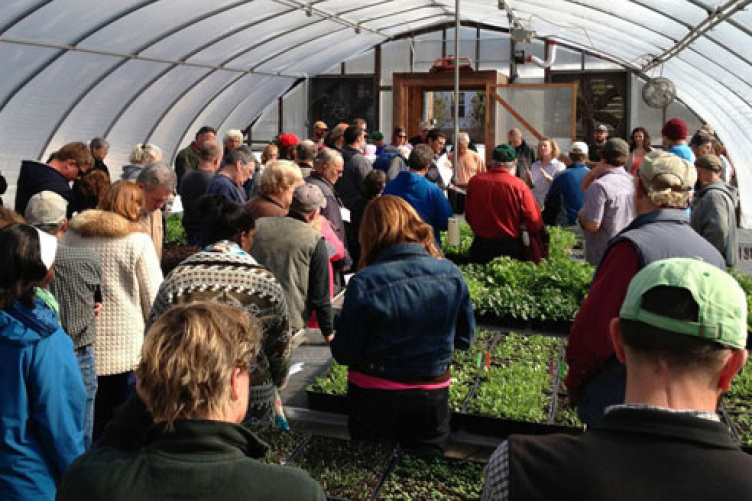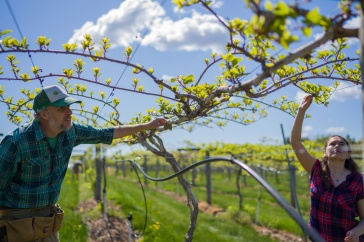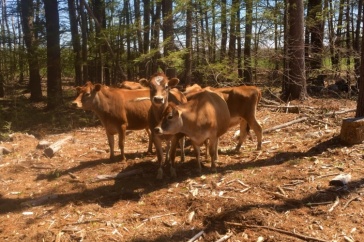
A UNH alumnus and co-owner of Demers Garden Center, a perennial and bedding plant mecca in the southeast corner of Manchester, Robert Demers has 22,000 square feet of greenhouse space, much of which lies empty in the off-season. Demers has been dabbling in vegetable production, and he says based on what he heard at a recent field day event hosted by UNH Cooperative Extension, he thinks winter greens would complement his existing business nicely.
“I think it’s going to be a good thing for me,” Demers said. “I’m pretty sure I have a market here. There are enough restaurants and locavores to fill the demand.”
The data backs him up. Demand for locally grown and produced food continues to grow, and so grows farming in New Hampshire — it is one of the few states seeing an upward trend.
That popularity explains why 92 commercial growers and greenhouse operators, including Demers, turned out to hear from UNH Cooperative Extension specialists Brian Krug and Becky Sideman and UNH graduate student Claire Collie at the Woodman Horticultural Farm this spring on Winter Greens Field Day. The UNH team has been collaborating on research to determine whether winter greens production could be a viable way to bring in profits during the typically dormant season.
Can winter salad greens be a profitable crop for greenhouse producers who have unused space during the fall and winter months? That’s what most of those in attendance at winter greens field day were interested in knowing.
In a Woodman Farm greenhouse, tiny mizuna, komastuna and arugula poke through the warm soil. Collie, Krug and Sideman are studying how temperature and planting date impact the growth rates of the greens. They’re also looking at which species are best suited for bench-top production — the method they are using at Woodman Farm. Plants grown in flats on benches have a different growth rate than those planted directly into greenhouse ground soil because the ground soil provides natural insulation.
Sideman says the idea for this research sprang from her trips to the busy winter farmers markets in the Seacoast area, where she noticed a dearth of greens and wondered if there was a way to increase the potential to produce them. It will be a few more months before the research, funded by the New Hampshire Department of Agriculture, Markets and Food Specialty Crop Block Grants Program and the New Hampshire Agricultural Experiment Station, is completed.
But Collie shared what they have learned so far. Early findings reveal that tatsoi and vitamin green are among the 21 varieties the researchers have tried and found to do well in this bench-top system. Collie says the brassica varieties “fun jen” and “Tokyo bekana” are particularly attractive options due to their mild flavor and yield. “Yield is key when you sell a crop by weight,” she says. Another early finding suggests that heating the greenhouse, while helpful in cutting time-to-harvest, does not result in a good return on the investment.
Collie, who is seeking a master’s degree in plant biology, has finished collecting data and will spend late spring and summer pulling together the findings. She’ll also develop an enterprise budget that growers can use as a tool to weigh the opportunity cost.
Extension greenhouse and floriculture specialist Brian Krug says that at this juncture growers seem bullish about the possibility.
“They will probably wait to see more of the economic analysis before officially deciding, but early indicators show that there is a lot of optimism about the potential for winter greens production,” Krug says.
Life is good (at 43° North)
Extension fruit and vegetable specialist Becky Sideman says that over the past decade or so, as consumers have become more aware of the many benefits of eating locally grown food, New Hampshire growers have become more sophisticated about extending the growing season to meet their demand. But there is still work to be done.
“We should not feel limited by our latitude,” Sideman says. “There are many ways to grow crops and continue to eat locally during the winter months given the right conditions.”
Sideman’s other research endeavors focus on season-extension techniques and crop diversification, for example, learning how to grow sweet potatoes successfully in the state.
She says this season-extension work — the trials, the cropping techniques — will ultimately help make New Hampshire more of a food oasis than a food desert. Currently, most of our produce comes from sources outside the state and region. Sideman would like to see that change.
“We should not feel limited by our latitude,” Sideman says. “There are many ways to grow crops and continue to eat locally during the winter months given the right conditions.”
Once Sideman, Collie and Krug pinpoint what these conditions are, they will share what they know broadly. Krug says if Collie’s results end up looking favorable for greenhouse growers, Extension would turn its focus towards getting concrete information into their hands through field days, seminars and other events to prepare them for success with this type of production.
Collie anticipates final results by September, just in time for the winter growing season.
—Tracey Bentley
Follow Claire Collie’s research. >>
Learn more about UNH Cooperative Extension’s work in fruit and vegetable production. >>
Learn more about UNH Cooperative Extension’s greenhouse and floriculture work. >>

















































